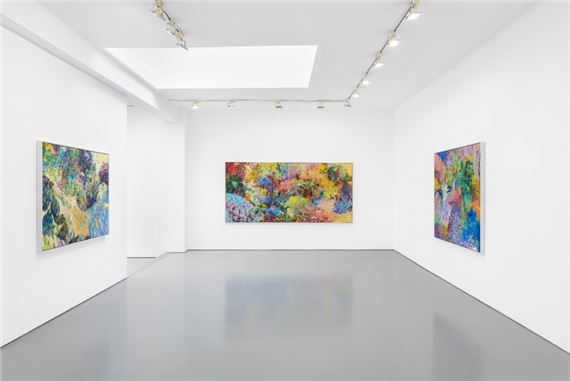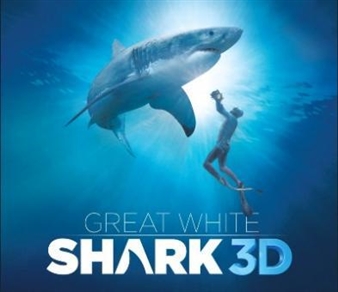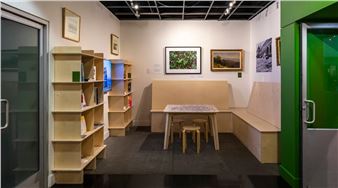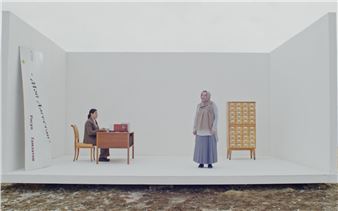Michael Alexander Campbell: Hansel, Gretel and Barbie on a Bike
Manhattan becomes a necropolis in August. Much of what you see, hear, and feel outside consists of the drip-drop, white-noise acrid heat plume blasting from AC units hanging by a thread out of tenement windows; the streets are emptied by provincial deserters and by locals retreating to the cooler confines of their walk-up apartments. Your sweat smells like deli meat and cigarettes, and you crouch in front of the cold fridge light which illuminates your kitchen at 5 a.m., cooling yourself off with leftover lo mein while trying to counter martini-induced dehydration with tepid $1 Poland Springs. But for me, the memory of the thick, hot air of summer 2023 is cut through with the noise of Michael Alexander Campbell clinking Bob Dylan’s Ballad of a Thin Man on the grand piano on the second residential floor of Julian Schnabel’s big pink Palazzo Chupi on West 11th Street.
I met Michael that summer, when he was working on huge psychedelic-looking paintings in the basement garage of Palazzo Chupi. Large canvasses laid unstretched on the floor, and colorful slashes of oil paint made out abstract shapes that somehow invited you into a world which was both strange and familiar. He would eventually be employed by Julian as well, and we quickly became friends, matching each other’s ability to spew rambling non sequiturs and indulging a shared obsession with various cultural scenes throughout New York’s history. We both lived Downtown – Michael in the East Village, I on the Lower East Side – a 20-minute walk door to door.
Michael came to New York at a peculiar point in time, painting against the backdrop of a strange culture. I call the years between 2022 and 2025 in New York the “intercrisis period,” the brief intermission between the pandemic and Trump 2.0. New York, a city known for being a progressive oasis in an increasingly nationalist United States, has not remained unaffected by political developments.
Downtown – particularly around my immediate area, which some refer to as Dimes Square –suddenly seemed overrun by crypto-worshipping groypers who had appointed themselves standard-bearers of a new, post-woke literary and artistic subculture that had emerged during the pandemic.
Nestled on the border between Chinatown and the Lower East Side, Dimes Square has come to be known as a physical place as well as a subculture. Division Street dead-ends into Canal Street – a diagonal exception to Manhattan’s otherwise iconic north-south, east-west grid system – creating a triangular square filled with outdoor seating belonging to various bars and restaurants. The area is known for its exquisite cash-only $4 dumpling joints, bodegas with scratch-off lottery tickets as well as fake diamond-studded dildos, and voluntarily starving, unbearably hip, irony-pilled writers and artists with a penchant for coining provocative slogans.
When Michael was new to New York, I would schlep him around to various readings, openings, and parties in Dimes Square. We went to The Shop, right at the foot of the rust-colored WilliamsburgBridge on Delancey Street, a sort of blind pig saloon that doubled as the headquarters of an insect extermination business, seemingly ripped straight from William Burroughs’ Naked Lunch.
Late nights were spent in Chinatown and Little Italy at pop-up parties with Catholic converts in constant conflict with most of the seven deadly sins. At Sovereign House, down the block from my old apartment, you’d be assaulted with information on the blockchain by extremely wealthy crypto dudes financing readings for poets exploring reactionary themes. We didn’t like the politics, but we liked that there was a scene.
Michael treated his apartment as if it were a hotel room, spending most of his time either roaming the cracked sidewalks of Downtown or working on large canvases on the black-painted rooftop of his Avenue B apartment building, where he stored his paints and brushes in a treasure chest. If I wanted company, I knew he wouldn’t be far off. We’d head to diners early in the morning, share a plate of pancakes, and revel in that solemn conviction that we were experiencing the nexus of some sort of something. Michael would constantly collect images, which he continues to use as reference material to this day – reworking and reinterpreting them in paint, abstracting the visuals while preserving their general form and composition. His camera roll is filled with photos of the city, tchotchkes he spots in antique shops, and screenshots of things and people on Instagram (…and sometimes even Hinge…).
His method of collecting and storing reference material is uniquely contemporary, yet the way he synthesizes it pays homage to the greats of the past. 2022–2025 felt like the last iteration of Downtown – the dusk of a culture that had always existed in Manhattan south of 14th Street and north of the Financial District, one that Michael and I managed to catch just as it was coming to an end. With dramatic cultural and political shifts in the U.S., and the cost of living rebounding to even greater heights after the brief period of cheaper rent during the pandemic, I became acutely aware of the impermanence of this scene – and of Manhattan’s ability able to host any scenes at all. Only time will tell what the lasting legacy of the Dimes Square scene will be, but its quality as a playful (if occasionally sinister) force – experimenting with high and low, social media-and-internet themes, and irony – has left an indelible mark on the artists like Michael, who spent some of their formative years bopping between readings and gallery openings within that physical and cultural geography.

Recommended for you
Manhattan becomes a necropolis in August. Much of what you see, hear, and feel outside consists of the drip-drop, white-noise acrid heat plume blasting from AC units hanging by a thread out of tenement windows; the streets are emptied by provincial deserters and by locals retreating to the cooler confines of their walk-up apartments. Your sweat smells like deli meat and cigarettes, and you crouch in front of the cold fridge light which illuminates your kitchen at 5 a.m., cooling yourself off with leftover lo mein while trying to counter martini-induced dehydration with tepid $1 Poland Springs. But for me, the memory of the thick, hot air of summer 2023 is cut through with the noise of Michael Alexander Campbell clinking Bob Dylan’s Ballad of a Thin Man on the grand piano on the second residential floor of Julian Schnabel’s big pink Palazzo Chupi on West 11th Street.
I met Michael that summer, when he was working on huge psychedelic-looking paintings in the basement garage of Palazzo Chupi. Large canvasses laid unstretched on the floor, and colorful slashes of oil paint made out abstract shapes that somehow invited you into a world which was both strange and familiar. He would eventually be employed by Julian as well, and we quickly became friends, matching each other’s ability to spew rambling non sequiturs and indulging a shared obsession with various cultural scenes throughout New York’s history. We both lived Downtown – Michael in the East Village, I on the Lower East Side – a 20-minute walk door to door.
Michael came to New York at a peculiar point in time, painting against the backdrop of a strange culture. I call the years between 2022 and 2025 in New York the “intercrisis period,” the brief intermission between the pandemic and Trump 2.0. New York, a city known for being a progressive oasis in an increasingly nationalist United States, has not remained unaffected by political developments.
Downtown – particularly around my immediate area, which some refer to as Dimes Square –suddenly seemed overrun by crypto-worshipping groypers who had appointed themselves standard-bearers of a new, post-woke literary and artistic subculture that had emerged during the pandemic.
Nestled on the border between Chinatown and the Lower East Side, Dimes Square has come to be known as a physical place as well as a subculture. Division Street dead-ends into Canal Street – a diagonal exception to Manhattan’s otherwise iconic north-south, east-west grid system – creating a triangular square filled with outdoor seating belonging to various bars and restaurants. The area is known for its exquisite cash-only $4 dumpling joints, bodegas with scratch-off lottery tickets as well as fake diamond-studded dildos, and voluntarily starving, unbearably hip, irony-pilled writers and artists with a penchant for coining provocative slogans.
When Michael was new to New York, I would schlep him around to various readings, openings, and parties in Dimes Square. We went to The Shop, right at the foot of the rust-colored WilliamsburgBridge on Delancey Street, a sort of blind pig saloon that doubled as the headquarters of an insect extermination business, seemingly ripped straight from William Burroughs’ Naked Lunch.
Late nights were spent in Chinatown and Little Italy at pop-up parties with Catholic converts in constant conflict with most of the seven deadly sins. At Sovereign House, down the block from my old apartment, you’d be assaulted with information on the blockchain by extremely wealthy crypto dudes financing readings for poets exploring reactionary themes. We didn’t like the politics, but we liked that there was a scene.
Michael treated his apartment as if it were a hotel room, spending most of his time either roaming the cracked sidewalks of Downtown or working on large canvases on the black-painted rooftop of his Avenue B apartment building, where he stored his paints and brushes in a treasure chest. If I wanted company, I knew he wouldn’t be far off. We’d head to diners early in the morning, share a plate of pancakes, and revel in that solemn conviction that we were experiencing the nexus of some sort of something. Michael would constantly collect images, which he continues to use as reference material to this day – reworking and reinterpreting them in paint, abstracting the visuals while preserving their general form and composition. His camera roll is filled with photos of the city, tchotchkes he spots in antique shops, and screenshots of things and people on Instagram (…and sometimes even Hinge…).
His method of collecting and storing reference material is uniquely contemporary, yet the way he synthesizes it pays homage to the greats of the past. 2022–2025 felt like the last iteration of Downtown – the dusk of a culture that had always existed in Manhattan south of 14th Street and north of the Financial District, one that Michael and I managed to catch just as it was coming to an end. With dramatic cultural and political shifts in the U.S., and the cost of living rebounding to even greater heights after the brief period of cheaper rent during the pandemic, I became acutely aware of the impermanence of this scene – and of Manhattan’s ability able to host any scenes at all. Only time will tell what the lasting legacy of the Dimes Square scene will be, but its quality as a playful (if occasionally sinister) force – experimenting with high and low, social media-and-internet themes, and irony – has left an indelible mark on the artists like Michael, who spent some of their formative years bopping between readings and gallery openings within that physical and cultural geography.

 ARTISTS
ARTISTS
















